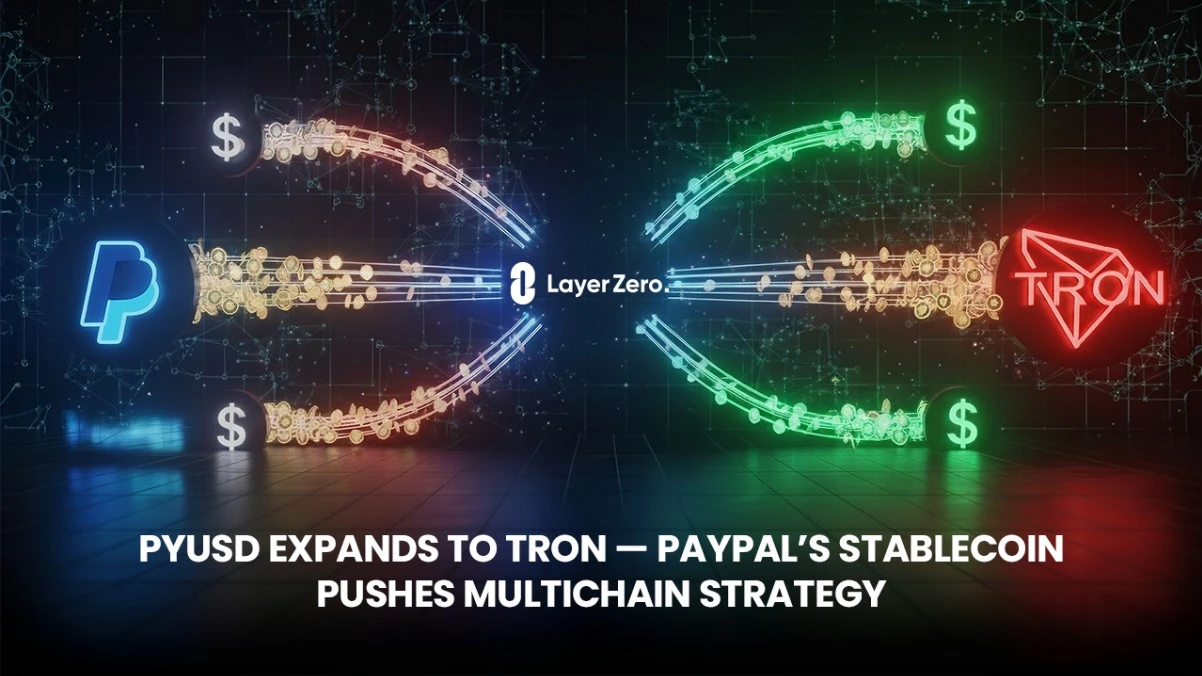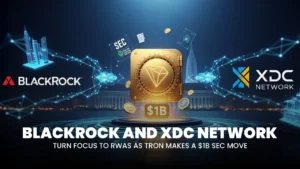PayPal’s PYUSD Lands on TRON Through LayerZero, Lifts Cross-Chain Reach to 1.3B

PayPal’s dollar stablecoin is stepping onto one of crypto’s busiest rails. On September 18, PayPal USD expanded to TRON through LayerZero’s Omnichain Fungible Token standard and Stargate Hydra, introducing PYUSD0 on TRON while maintaining one-to-one fungibility with native PYUSD on other chains.
- Why Tron, Why Now
- What Is Actually Shipping?
- Industry Context: Stablecoin Competition And Payments Rail Strategy
- What Participants Are Saying?
- What Adoption Could Look Like On Tron
- Risks And Caveats
- Market Reaction And Near-Term Outlook
- Conclusion
- Frequently Asked Questions About PYUSD On Tron
- Is PYUSD on Tron the same asset as PYUSD on Ethereum?
- Which chains have native PYUSD and which use PYUSD0?
- Why is TRX attractive for PYUSD?
- How big is PYUSD today?
- Does this change USDC’s status on Tron?
- Will users have to bridge funds manually?
- Is PYUSD on Tron governed by DPoS?
- Are there risks to using PYUSD0?
- How might exchanges respond?
- Does this help merchants?
- Glossary of Key Terms
Tron’s delegated proof of stake design, known for fast finality and low fees, is built for payments at scale and aligns with PayPal’s push to make digital dollars easy to move across everyday venues. The rollout is part of a broader expansion to additional blockchains aimed at meeting users where they already transact.
ALSO READ: eToro Onboards XDC as Circle Anchors USDC Settlement for Global Trade Finance
Why Tron, Why Now
Tron’s draw is simple: very low fees, high throughput, and a payments-heavy user base that already leans on stablecoins. Tron uses Delegated Proof of Stake, or DPoS, where elected Super Representatives validate the network, a model that prioritizes speed and predictability for transactional use cases. That makes it a natural venue for a payment stablecoin.
As of mid-September 2025, data shared in launch coverage points to more than 332 million total user accounts on Tron, over 11 billion total transactions, and north of 28 billion in total value locked. Those are precisely the kinds of scale metrics payments firms look for when choosing distribution.
LayerZero’s role is the connective tissue. The project’s OFT standard and Stargate Hydra bridge let PayPal offer a permissionless PYUSD0 that can live on additional chains such as Tron, Avalanche, Aptos, Abstract, Ink, Sei, and Stable, while keeping PYUSD and PYUSD0 fully fungible. In practice, the user sees PYUSD on more chains without manual wrapping steps.
What Is Actually Shipping?
The technical detail that matters is naming and fungibility. PYUSD0 is the permissionless token representing PayPal USD on new chains, including Tron.
LayerZero states that whether someone holds PYUSD or PYUSD0, it is one unified PayPal USD stablecoin across blockchains. No action is required by end users to reconcile the two. Interoperability is handled under the hood by LayerZero and Stargate Hydra.
Media coverage across Decrypt, CoinDesk, The Block, and Cointelegraph confirms the expansion to nine additional blockchains through LayerZero, with Tron among the headline destinations. PYUSD’s circulating supply stands at roughly 1.3 billion, a level several outlets highlighted in their coverage of the expansion.
The DPoS Angle And Why It Fits PYUSD
Stablecoins shine when settlement is cheap and finality is fast. Tron’s DPoS design is explicitly optimized for high throughput and low fees by having token holders elect a capped set of validators called Super Representatives. Because block production is scheduled, confirmation times tend to be consistent.
For a consumer payments-minded stablecoin, those attributes translate into a predictable user experience and lower friction for merchants and remitters. The expansion, therefore, aligns PYUSD with a DPoS network that already clears massive stablecoin volume daily.
DPoS is also familiar to the many retail users onboarded through exchanges and fintechs that integrated Tron over the last several years. That user familiarity can reduce support burden for wallet providers and exchanges once PYUSD0 volumes pick up on Tron. The positive framing from Tron DAO and LayerZero around accessibility and distribution underscores that strategic fit.
ALSO READ: Sui Links Up with Bitkub as Thailand Pushes Web3 Education and Scale
Industry Context: Stablecoin Competition And Payments Rail Strategy
PayPal is not alone in its race to make it easy to move dollars online across different chains. Circle has been pushing native USDC portability via its Cross Chain Transfer Protocol, with a recent announcement that CCTP v2 is coming to Stellar to expand native USDC transfers.
In parallel, Circle has been building out exchange and app integrations, including a Hyperliquid tie-up announced this week. The net effect is a more competitive, more connected stablecoin landscape.
There is also a notable plot twist on Tron specifically. Circle discontinued support for minting USDC on Tron in 2024, with transfers off Tron supported through February 2025. That decision created a gap for a mainstream payments brand on TRON. PYUSD’s arrival via PYUSD0 is poised to fill at least part of that demand for a regulated fintech-issued dollar token on the network.
What Participants Are Saying?
LayerZero emphasized that PYUSD0 is fully fungible with native PYUSD and that the integration is about reaching users where they are, with distribution spanning additional chains through Hydra. The team framed it as enabling broader availability while preserving compliance and composability.
Tron DAO cast stablecoins as a clear use case of crypto in the real economy and pitched the launch as increasing accessibility for users and institutions. Press syndications and coverage quoted Founder Justin Sun, highlighting remittances and payments as drivers of adoption. (markets.businessinsider.com)
Two recent posts capture the tone of the day.
LayerZero highlights the goal of greater PYUSD availability across blockchains:
PayPal built the first global digital payment network at the onset of the internet age. In 2023, they were the first major fintech company to launch a stablecoin with PYUSD.
With PYUSD0, PayPal and LayerZero are working to drive greater availability of PYUSD across blockchains. pic.twitter.com/CWOc2CP6sA
— LayerZero (@LayerZero_Core) September 18, 2025
Tron DAO announces PYUSD on Tron with a launch graphic and timestamp on September 18, 2025:
.@trondao announced today that @PayPal USD will be available on the TRON network through @StargateFinance Hydra as a permissionless token, PYUSD0, leveraging @LayerZero_Core’s Omnichain Fungible Token (OFT) Standard.
More details from @Cointelegraph 👇https://t.co/6ZhufbQBts pic.twitter.com/FoieAhJo7p
— TRON DAO (@trondao) September 18, 2025
Where PYUSD Is Native And Where It Uses PYUSD0
Below is a quick reference based on the day’s announcements and coverage.
| Category | Blockchains | Notes |
| Native PYUSD live today | Ethereum, Solana, Arbitrum, Stellar | Issued by Paxos as PYUSD on these chains. (CoinDesk) |
| PYUSD0 via LayerZero Hydra | Tron, Avalanche, Aptos, Abstract, Ink, Sei, Stable, with upgrades from Berachain and Flow | PYUSD0 is permissionless and fully fungible 1 to 1 with native PYUSD. (LayerZero) |
What Adoption Could Look Like On Tron
Tron’s stablecoin-heavy economy is an obvious on-ramp. Until recently, Tron hosted the largest floating supply of USDT, reflecting a user base comfortable with stablecoins for savings, trading, and transfers.
In that context, PYUSD0 could find traction in merchant payments, peer-to-peer transfers, and exchange treasury flows. Even modest share gains could be material for a 1.3 billion supply token.
DPoS governance may help operational integrations move quickly. Because Tron’s validator set is small and elected, coordinated upgrades and route additions at exchanges and wallets can be more straightforward than on networks with hundreds of validators. For a payments brand measuring customer satisfaction in seconds, the predictability that DPoS provides is a commercial advantage
Risks And Caveats
Stablecoin distribution is not just a technical exercise. It carries compliance and reputational risks, especially on networks that have occasionally drawn regulatory scrutiny. The history around Circle ending USDC support on Tron in 2024 is relevant context, as were exchange-level decisions that followed.
PayPal’s structure for PYUSD issuance and controls, plus LayerZero’s interoperability stack, will likely be tested by counterparties and regulators as volumes migrate across chains.
Interoperability standards also carry operational risk. PYUSD0 relies on mint and burn mechanisms and cross-chain messaging. While Hydra and OFT are designed to abstract complexity, developers still need to treat bridge routes with the same diligence they apply to custody and key management. The promise of PYUSD0 is that users should not have to think about any of this. The challenge is to keep it that way at scale.
ALSO READ: Sui Buyback Signals Balance Sheet Conviction as Tron’s Block Size Scales a 2-Year Peak
Market Reaction And Near-Term Outlook
Price action in Tron’s native token TRX has been modestly positive into and after the announcement, with some outlets citing a short-term bounce. But the more interesting signal will be on chain settlement.
If PYUSD0 catches on in remittances, exchange treasury routing, and retail payments in Tron’s ecosystem, the daily transfer count should show it. The DAO is already positioning the integration as a way to serve both users and institutions looking for stable, low-cost rails.
DPoS networks like Tron have historically proven sticky for stablecoin users once network effects kick in. With PYUSD0 in the mix, PayPal has quietly assembled coverage across Ethereum, Solana, Arbitrum, Stellar, and now a list of permissionless deployments. If the firm keeps the user experience uniform across those endpoints, the brand can lean on its fintech DNA while benefiting from DPoS scale where it matters most: checkout, bill pay, and cross-border transfers.
Conclusion
PayPal’s step onto TRON through LayerZero is a targeted distribution move aimed at active stablecoin users. The decision leans on the strengths of a Delegated Proof of Stake (DPoS) model that clears large volumes at low cost while preserving brand-level controls around issuance.
If adoption follows the pattern TRON has seen with other dollar tokens, PYUSD0 could deepen its role in day-to-day payments, remittances, and treasury flows. The cross-chain design lets PYUSD meet users where they are, while fungibility with native PYUSD keeps operational complexity out of sight. The multichain race among dollar tokens is intensifying, and this is PayPal’s most assertive entry yet.
Frequently Asked Questions About PYUSD On Tron
Is PYUSD on Tron the same asset as PYUSD on Ethereum?
Yes. PYUSD0 on Tron is permissionless and fully fungible one-to-one with native PYUSD. Users should see it as the same PayPal USD stablecoin across chains.
Which chains have native PYUSD and which use PYUSD0?
Native issuance is on Ethereum, Solana, Arbitrum, and Stellar. PYUSD0 extends PYUSD to additional chains, including Tron, Avalanche, Aptos, Abstract, Ink, Sei, and Stable, while Berachain and Flow versions upgrade to PYUSD0.
Why is TRX attractive for PYUSD?
Tron’s Delegated Proof of Stake model supports high throughput and low fees, making it well-suited for payments, remittances, and exchange flows where stablecoins dominate.
How big is PYUSD today?
Media reports place PYUSD’s circulating supply around 1.3 billion as of September 18, 2025.
Does this change USDC’s status on Tron?
No. Circle discontinued minting USDC on TRX in 2024 and supported migrations through February 2025. PYUSD’s rollout does not reverse that.
Will users have to bridge funds manually?
LayerZero’s architecture and Stargate Hydra aim to remove manual wrapping steps. The design goal is seamless movement with PYUSD and PYUSD0 treated as one asset.
Is PYUSD on Tron governed by DPoS?
TRX network security and block production rely on DPoS with elected Super Representatives. PYUSD0 simply rides that infrastructure like any Tron token.
Are there risks to using PYUSD0?
As with any cross-chain design, users should rely on reputable routes and providers. The underlying mechanism uses mint and burn messaging between chains. Counterparty and bridge hygiene still matter.
How might exchanges respond?
Coverage indicates several exchanges and ecosystems are already integrating the new routes. Expect listings and routing support to expand if on-chain demand is strong.
Does this help merchants?
Lower transaction costs and faster finality on a DPoS chain can reduce checkout friction. Broader distribution means the same dollar token is available to more customers.
Glossary of Key Terms
Stablecoin: A crypto token designed to hold a stable value, typically pegged to the US dollar.
Delegated Proof of Stake: A consensus model where token holders elect validators to produce blocks and secure the network.
Super Representative: An elected TRON validator responsible for block production and governance proposals.
Fungibility: Interchangeability of units of an asset, allowing one unit to be swapped for another without loss of value.
Interoperability: The ability for assets and messages to move across different blockchains.
OFT Standard: LayerZero’s Omnichain Fungible Token specification for interoperable tokens across chains.
Stargate Hydra: LayerZero’s interface for cross-chain transfers that supports PYUSD0 distribution.
Mint and Burn: A Mechanism used to move assets across chains by destroying on one chain and issuing on another.
TVL: Total value locked, a measure of assets deposited in a blockchain’s smart contracts.
Remittances: Cross-border money transfers, often benefiting from low fees and fast settlement on DPoS networks.




